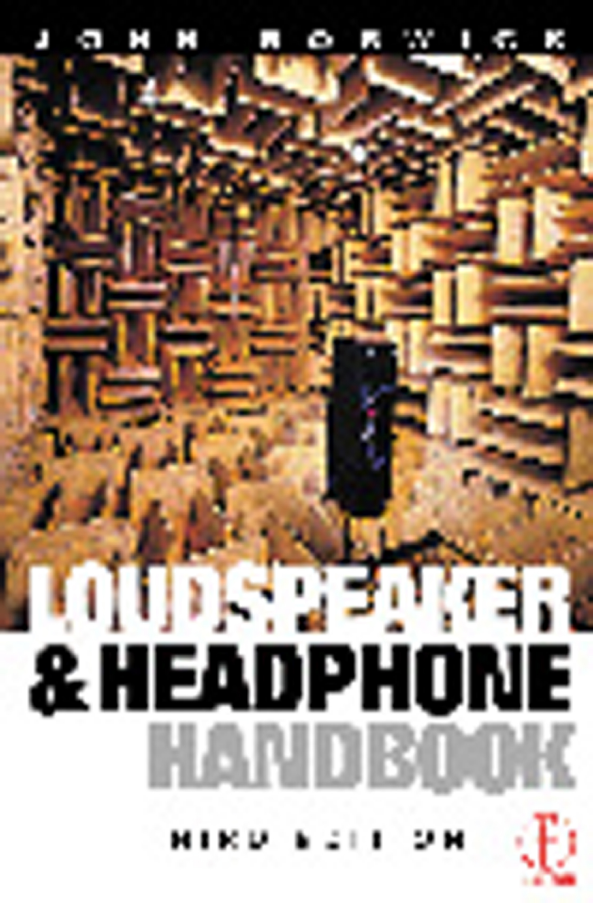Front Cover
Loudspeaker and Headphone Handbook
Copyright Page
Contents
Preface to the third edition
List of contributors
Chapter 1. Principles of sound radiation
1.1 Introduction
1.2 Acoustic wave propagation
1.3 Sources of sound
1.4 Multiple sources and mutual coupling
1.5 Limitations of the infinite baffle loudspeaker model
1.6 Horns
1.7 Non-linear acoustics
References
Appendix: Complex numbers and the complex exponential
Chapter 2. Transducer drive mechanisms
2.1 A short history
2.2 The diaphragm
2.3 Diaphragm material
2.4 Magnetism
2.5 The coil
2.6 The case for square wire
2.7 The suspension
2.8 Motor performance
2.9 The chassis
2.10 Efficiency
2.11 Power handling and heat dissipation
2.12 The dome driver
2.13 The horn driver
2.14 The ribbon loudspeaker
2.15 Moving masses
2.16 Modelling the moving-coil motor
2.17 The electrical analog of a drive unit
2.18 Modelling the enclosure
2.19 Low-frequency reproduction
2.20 The compound loudspeaker
2.21 Motional feedback
References
Chapter 3. Electrostatic loudspeakers
3.1 Introduction
3.2 Electrostatic drive theory
3.3 Radiating the sound
3.4 Practical designs
3.5 A general principle
3.6 Safety
Acknowledgements
References
Chapter 4. The distributed mode loudspeaker (DML)
4.1 Introduction
4.2 Historical background
4.3 Traditional loudspeakers
4.4 Bending waves in beams and plates
4.5 Optimizing modal density
4.6 Early work
4.7 Current methodologies
4.8 Panel mechanical measurements
4.9 Drive points
4.10 Mechanical model
4.11 Implementation for a practical moving-coil exciter
4.12 Radiation simulation modelling
4.13 Performance
4.14 Acoustical measurements
4.15 Psychoacoustics
4.16 Loudness
4.17 Stereophonic localization
4.18 Boundary reaction
4.19 Acoustic feedback margin
4.20 Sound reinforcement applications
4.21 Distortion mechanisms
4.22 The future
Acknowledgements
References
Chapter 5. Multiple-driver loudspeaker systems
5.1 Introduction
5.2 Crossover networks – theoretical design criteria
5.3 Practical system design procedures
5.4 Summary
References
Bibliography
Chapter 6. The amplifier/loudspeaker interface
6.1 Introduction
6.2 The electrical load presented by the loudspeaker
6.3 Impedance compensation
6.4 Complete conjugate impedance compensation
6.5 Sound level and amplifier power
6.6 Remote crossovers, remote or built-in amplifiers?
6.7 Damping factor and source resistance
6.8 Level rather than watts
6.9 Axial SPL and room loudness
6.10 Active loudspeaker systems
6.11 A typical active speaker system
6.12 Driver equalization and motional feedback (MFB)
6.13 Full-range feedback
6.14 Speaker adaptability
6.15 Digital loudspeakers
6.16 Cables and connectors
References
Bibliography
Chapter 7. Loudspeaker enclosures
7.1 Introduction
7.2 Lumped-parameter modelling
7.3 Enclosure types
7.4 Mechanical considerations
7.5 Acoustical considerations
7.6 Finite element modelling
Appendix: Computer model
References
Chapter 8. The room environment: basic theory
8.1 Introduction
8.2 Basic room acoustics
8.3 Loudspeaker placement
8.4 Measurement of room acoustics
8.5 Listening room design
8.6 Frequency response equalization
Acknowledgements
References
Bibliography
Chapter 9. The room environment: problems and solutions
9.1 Introduction
9.2 Room equalization
9.3 Correctable and non-correctable responses
9.4 Digital correction techniques
9.5 Related problems in loudspeakers
9.6 Equalization in auditoria
9.7 An example of simple acoustic equalization
9.8 Acoustic solutions
9.9 Source pattern differences
9.10 Listening rooms
9.11 Critical distance
9.12 Control rooms
9.13 The advent of specialized control rooms
9.14 Built-in monitors
9.15 Directional acoustics
9.16 Scaling problems
9.17 The pressure zone
9.18 The general behaviour of loudspeakers in rooms
9.19 Summing up
Acknowledgements
References
Bibliography
Chapter 10. Sound reinforcement and public address
10.1 Introduction
10.2 Loudspeakers and signal distribution
10.3 Loudspeaker coverage
10.4 Sound systems for auditoria
10.5 Time delay and the Haas effect
10.6 Response shaping
10.7 Speech intelligibility
10.8 Outdoor PA systems
10.9 Climatic effects
10.10 Sound-masking systems
10.11 Reverberation enhancement
10.12 Electronic architecture
10.13 Cinema sound systems
10.14 Sound system performance and design prediction
10.15 Microphones
References
Bibliography
Chapter 11. Loudspeakers for studio monitoring and musical instruments
Part 1: Studio Monitor Loudspeakers
11.1 Introduction
11.2 Studio monitor performance requirements
11.3 Significant monitor designs
Part 2: Musical Instrument Loudspeakers
11.4 Musical instrument direct-radiator driver construction
11.5 Musical instrument loudspeaker enclosures and systems
Part 3: The Digital Future
11.6 Electronic speaker modelling, digital input and control, and the possibility of the digital loudspeaker
References
Bibliography
Chapter 12. Loudspeaker measurements
12.1 Introduction
12.2 Measurement standards
12.3 The measurement environment
12.4 Measuring conditions
12.5 Characteristics measurements: small-signal
12.6 Large-signal measurements: distortion-limited
12.7 Large-signal measurements: damage-limited
12.8 Mechanical measurements
12.9 Integrated measurement systems
Acknowledgements
References
Chapter 13. Subjective evaluation
13.1 Introduction
13.2 Turning listening tests into subjective measurements: identifying and controlling the nuisance variables
13.3 Electrical requirements
13.4 Experimental method
13.5 Statistical analysis of results
13.6 Conclusions
References
Chapter 14. Headphones
14.1 Introduction
14.2 Acoustics of headphones
14.3 The hearing mechanism
14.4 Headphone applications
14.5 Practical matters
References
Chapter 15. International standards
15.1 Introduction
15.2 Standards-making bodies
15.3 Standards for loudspeakers
References
Chapter 16. Terminology
16.1 Introduction
16.2 Definitions
16.3 Quantities and symbols
References
Index
















 2023年江西萍乡中考道德与法治真题及答案.doc
2023年江西萍乡中考道德与法治真题及答案.doc 2012年重庆南川中考生物真题及答案.doc
2012年重庆南川中考生物真题及答案.doc 2013年江西师范大学地理学综合及文艺理论基础考研真题.doc
2013年江西师范大学地理学综合及文艺理论基础考研真题.doc 2020年四川甘孜小升初语文真题及答案I卷.doc
2020年四川甘孜小升初语文真题及答案I卷.doc 2020年注册岩土工程师专业基础考试真题及答案.doc
2020年注册岩土工程师专业基础考试真题及答案.doc 2023-2024学年福建省厦门市九年级上学期数学月考试题及答案.doc
2023-2024学年福建省厦门市九年级上学期数学月考试题及答案.doc 2021-2022学年辽宁省沈阳市大东区九年级上学期语文期末试题及答案.doc
2021-2022学年辽宁省沈阳市大东区九年级上学期语文期末试题及答案.doc 2022-2023学年北京东城区初三第一学期物理期末试卷及答案.doc
2022-2023学年北京东城区初三第一学期物理期末试卷及答案.doc 2018上半年江西教师资格初中地理学科知识与教学能力真题及答案.doc
2018上半年江西教师资格初中地理学科知识与教学能力真题及答案.doc 2012年河北国家公务员申论考试真题及答案-省级.doc
2012年河北国家公务员申论考试真题及答案-省级.doc 2020-2021学年江苏省扬州市江都区邵樊片九年级上学期数学第一次质量检测试题及答案.doc
2020-2021学年江苏省扬州市江都区邵樊片九年级上学期数学第一次质量检测试题及答案.doc 2022下半年黑龙江教师资格证中学综合素质真题及答案.doc
2022下半年黑龙江教师资格证中学综合素质真题及答案.doc